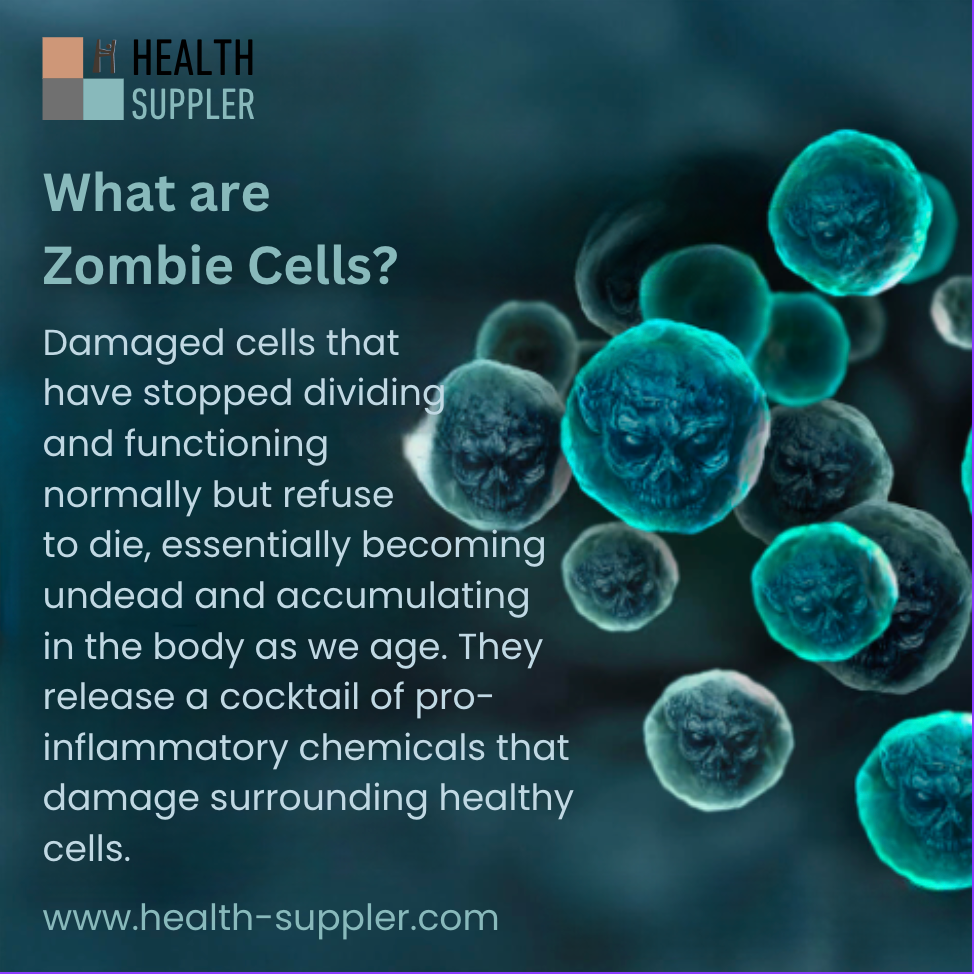
Cellules zombies : leur impact sur la santé et le vieillissement
Partager
Cellules zombies : ce qu'elles sont et comment les éliminer
Avez-vous déjà entendu parler des cellules zombies ? Même si elles ne vous transforment pas forcément en zombie, ces cellules endommagées et persistantes peuvent sérieusement affecter votre santé. Les cellules zombies cessent de se diviser et de fonctionner correctement, mais refusent obstinément de mourir, s'accumulant dans votre corps et endommageant les cellules et tissus sains.
Dans cet article, nous allons découvrir ce que sont les cellules zombies et pourquoi elles sont importantes pour votre santé. Vous découvrirez leurs caractéristiques, comment elles s'accumulent et les symptômes associés à une charge élevée de cellules zombies.
Je partagerai également des stratégies éprouvées pour les réduire et recommanderai des suppléments efficaces pour vous aider à éliminer ces cellules nocives et à restaurer votre bien-être.
Prenez le contrôle de votre santé en apprenant à combattre les cellules zombies et à devenir une personne plus saine et plus dynamique !
Que sont les cellules zombies ?
Dans le cycle de vie normal d'une cellule, les cellules vieilles ou endommagées cessent de se répliquer, subissent une mort cellulaire programmée (apoptose) et sont éliminées par l'équipe de nettoyage de votre corps, les phagocytes. Les cellules zombies, en revanche, ne suivent pas ce processus. Au lieu de mourir, elles entrent dans un état appelé sénescence, ce qui signifie qu'elles cessent de se diviser mais refusent de mourir.
Ces cellules « mortes » persistent et s’accumulent dans votre corps à mesure que vous vieillissez. Mais elles ne restent pas inactives. Les cellules zombies émettent des signaux anormaux qui peuvent pousser les cellules saines voisines vers la sénescence, créant ainsi davantage de cellules zombies. Elles émettent également un mélange de substances chimiques pro-inflammatoires qui endommagent les tissus environnants. Cela contribue à un phénomène connu sous le nom d’inflammaging, une inflammation chronique de faible intensité qui accélère le vieillissement et nuit à votre santé.
Comprendre les cellules zombies est essentiel pour lutter contre leurs effets nocifs et favoriser un vieillissement en bonne santé.
Comment se forment les cellules zombies ?
D'où viennent les cellules zombies et quelles en sont les causes ? La sénescence cellulaire peut survenir pour diverses raisons, mais elle se produit principalement comme un mécanisme de protection pour empêcher un stress ou des dommages supplémentaires dus à la réplication cellulaire en cours.
Types de sénescence cellulaire
-
Sénescence réplicative
Ce phénomène se produit lorsqu'une cellule atteint son nombre maximal de divisions, appelé limite de Hayflick. À ce stade, les télomères (capuchons protecteurs situés aux extrémités des chromosomes) deviennent trop courts, ce qui empêche toute réplication ultérieure. -
Sénescence induite par un oncogène
Les oncogènes sont des gènes qui régulent la réplication cellulaire. Lorsqu'ils sont activés ou surexprimés, ils peuvent entraîner une prolifération cellulaire excessive. Pour empêcher la formation de tumeurs, l'organisme déclenche deux voies de suppression des tumeurs, qui induisent simultanément la sénescence de ces cellules hyperactives. -
Sénescence induite par le stress
Les facteurs de stress externes tels que les radicaux libres, les rayonnements ionisants et les agents oxydants peuvent provoquer des cassures monocaténaires dans l'ADN. Ces cassures activent la réponse aux dommages de l'ADN, entraînant potentiellement les cellules saines vers une sénescence prématurée. -
Sénescence induite par l'irradiation
L'exposition aux rayons UV peut ioniser les nucléotides de l'ADN, ce qui entraîne des dommages à l'ADN et l'induction d'une sénescence, en particulier dans les cellules de la peau. Cela explique la concentration plus élevée de cellules zombies souvent trouvées dans la peau âgée ou endommagée par le soleil.
